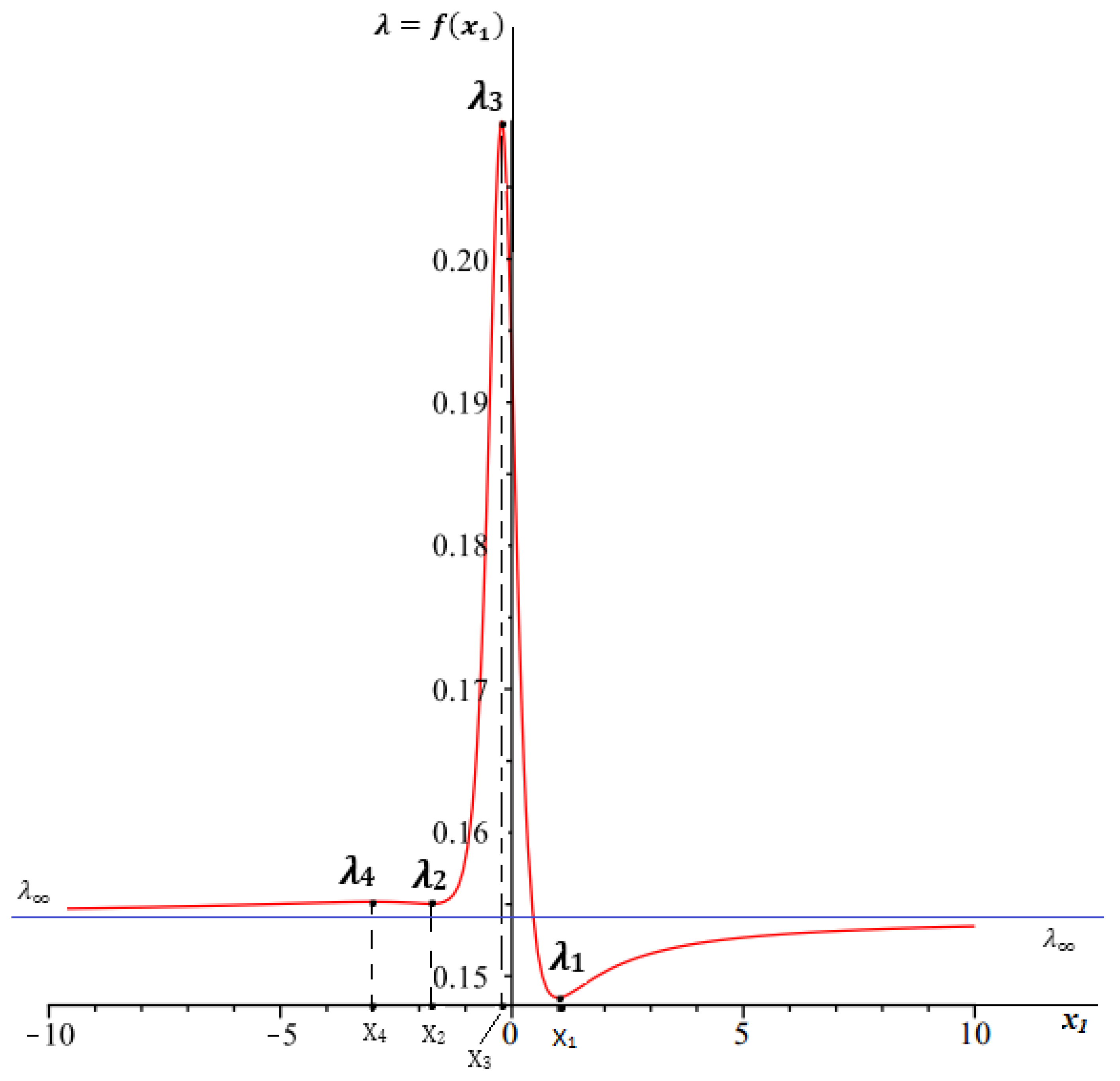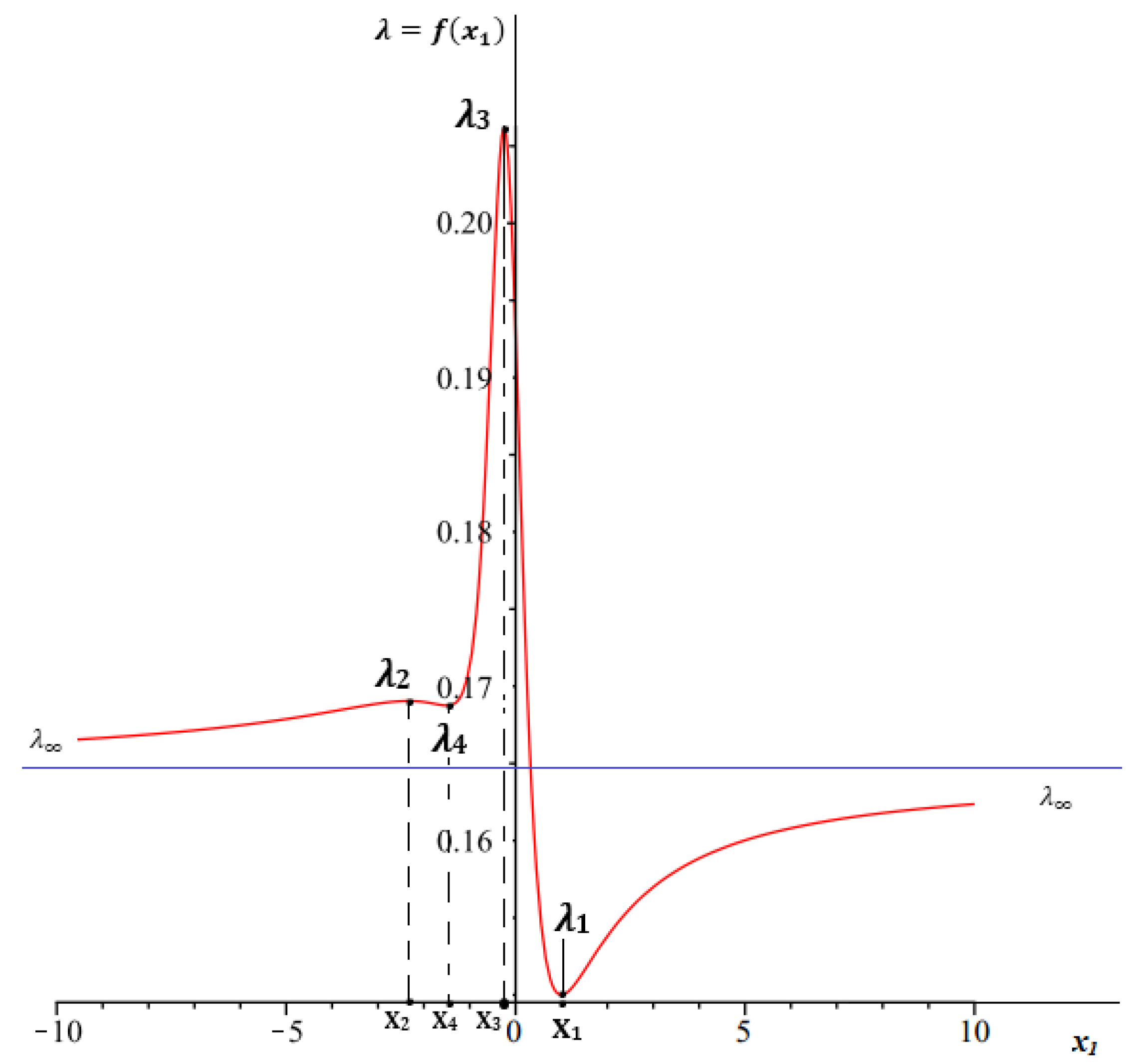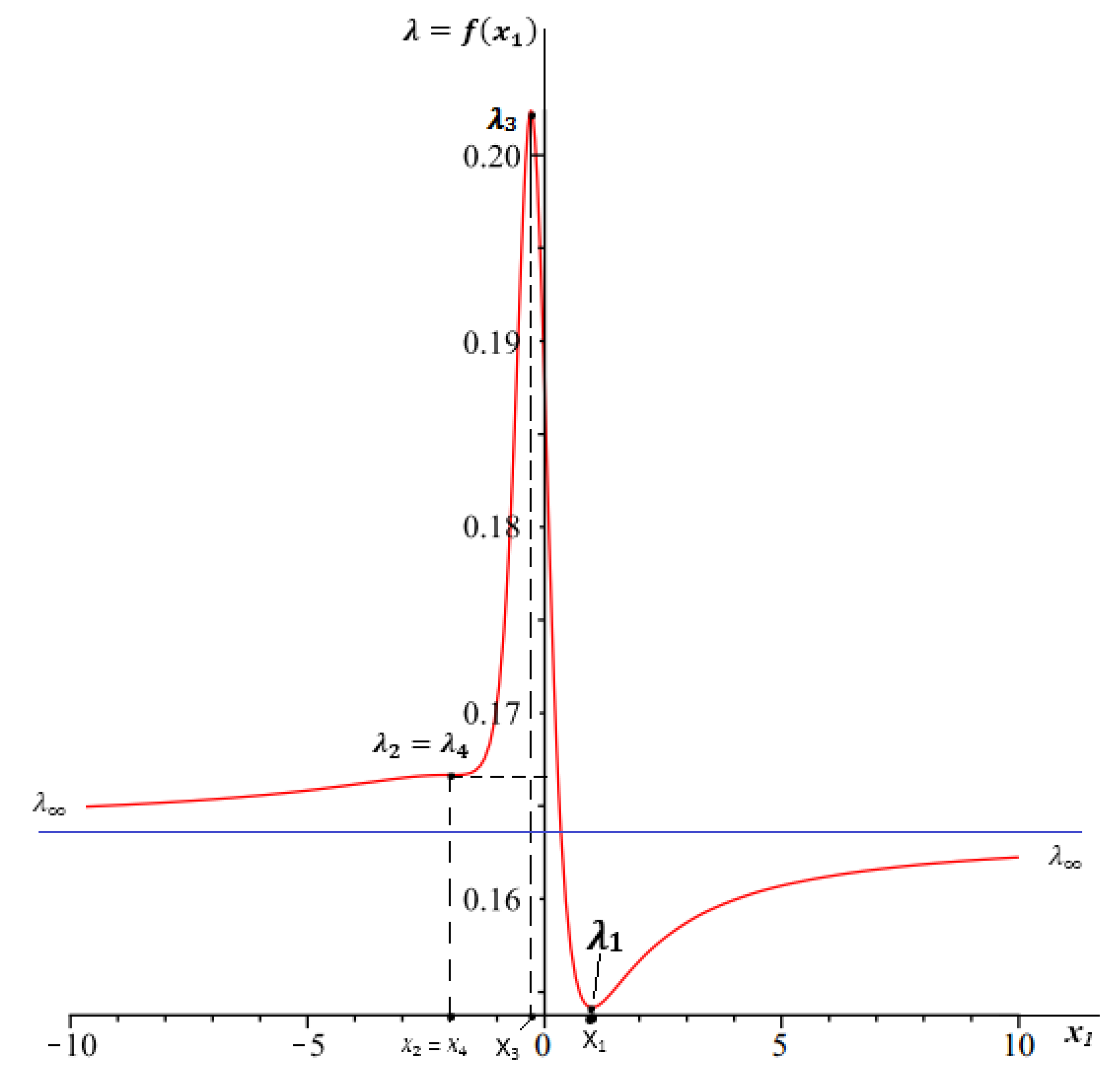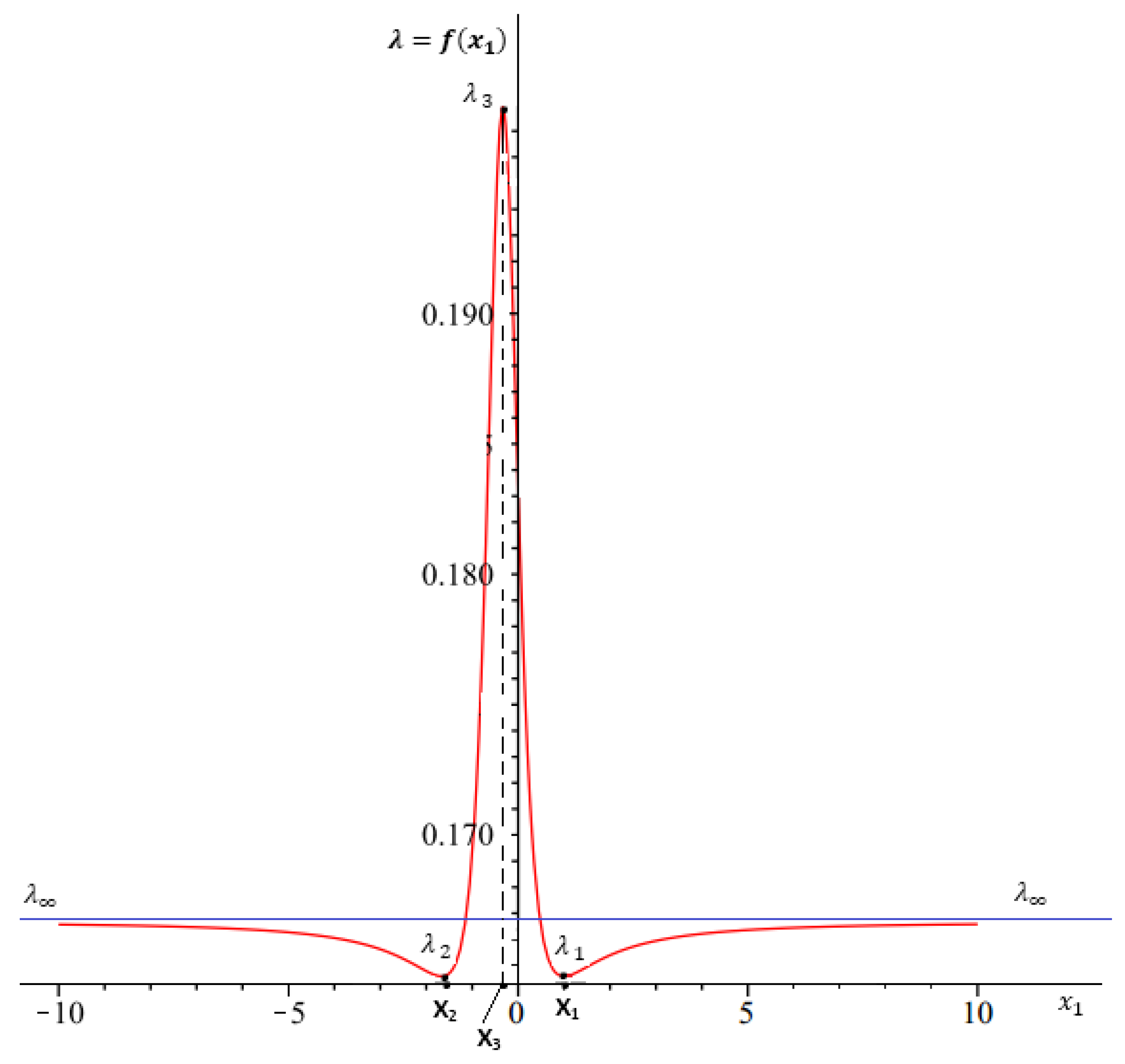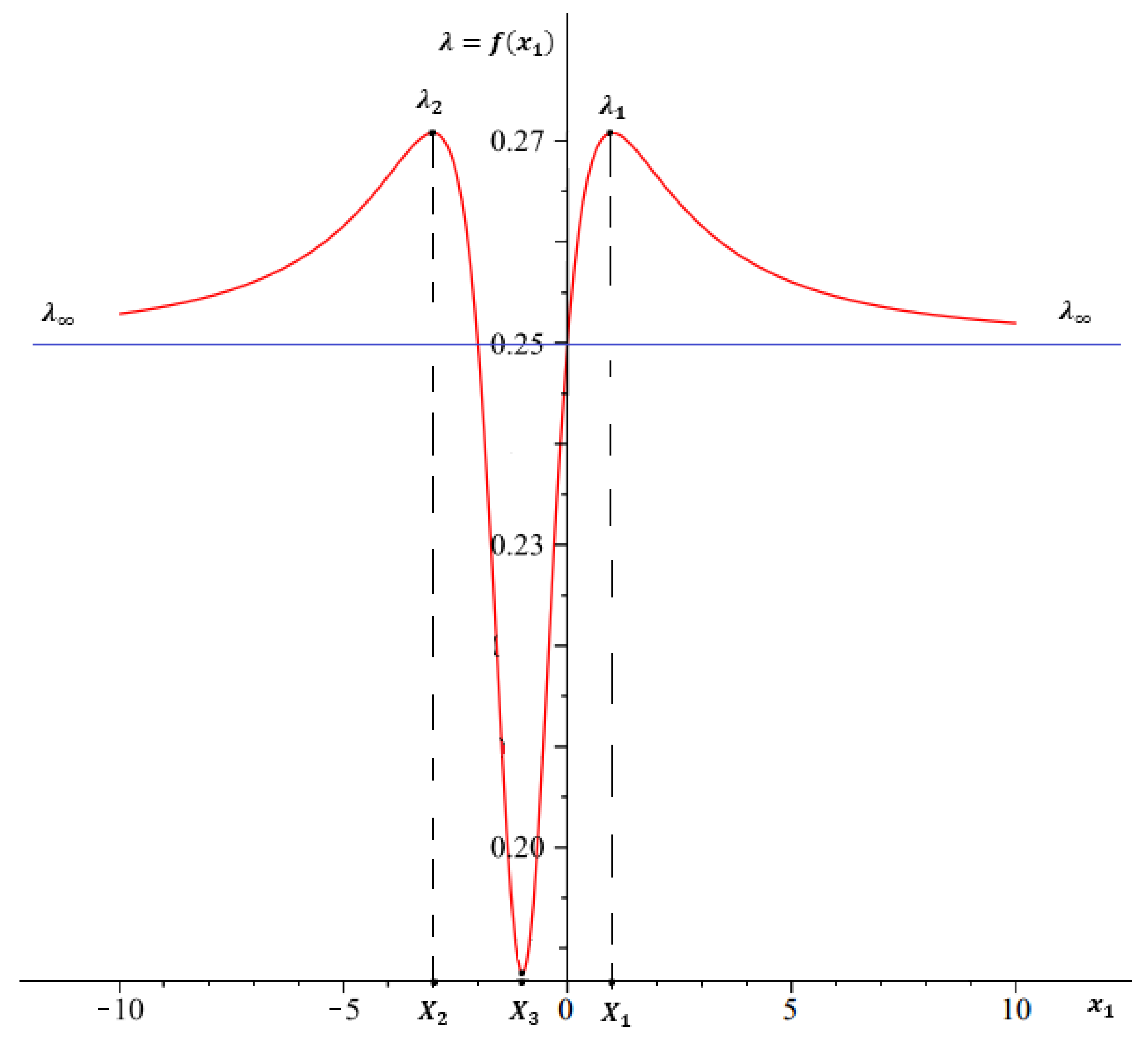1. Introduction
Here, we deal with a
D-dimensional Einstein–Gauss–Bonnet (EGB) model with a
term. This model is unique among the other higher dimensional extensions of General Relativity (GR) with the second order in the curvature terms since the equations of motion for this model are of the second order (in derivatives) as takes place in Einstein gravity. It is well known that the so-called Gauss–Bonnet term appeared in (super)string theory as a first order correction (in
) to the (super)string effective action (e.g., the heterotic one) [
1,
2,
3,
4].
At present, the EGB gravitational model in diverse dimensions and its modifications (see [
5,
6,
7,
8,
9,
10,
11,
12,
13,
14,
15,
16,
17,
18,
19,
20,
21,
22,
23,
24,
25,
26,
27,
28,
29,
30,
31,
32,
33] and the references therein) are rather popular objects for study in cosmology, e.g., for a possible explanation of the accelerating expansion of the Universe (i.e., solving the dark energy problem), which follow from supernova (type Ia) observational data [
34,
35,
36]. It may be expected that the second order form of the equations of motion for these models will lead us to solutions that are in some sense close to those coming from GR and its higher dimensional extensions (e.g., avoiding the ghost branches at least).
For given
D-dimensional manifold
M with the metric
g, the EGB model is a particular case of the Lovelock model [
37] with the action:
where
,
are constants (
) and
is the
term, for which a certain polynomial of Riemann tensor of
power:
,
(scalar curvature),
(the Gauss–Bonnet term), etc. For even dimensions
, the integral
is topologically invariant, i.e., it has a zero variation with respect to the metric and contributes to the equations of motion. For the Riemannian metric
g defined on a closed (oriented) manifold
M, this invariant is proportional to the Euler characteristic
of this manifold; this was proven by S.S.Chern in [
38] (the so-called Chern or Chern–Gauss–Bonnet theorem). The equations of motion for the Lovelock model have at most second order derivatives of the metric as takes place for the EGB model. It should be noted that at present, there exist several modifications of Einstein and EGB actions, which correspond to the
,
, and
theories (e.g., for
). These modifications are intensively studied in the literature devoted to cosmological, astrophysics and other applications; see [
31,
32,
33] and the references therein.
In this paper, we restrict ourselves to diagonal metrics and study a class of cosmological solutions with the exponential time dependence of three scale factors, governed by three non-coinciding Hubble-like parameters:
,
, and
, corresponding to factor spaces of dimensions 3,
, and
, respectively, with a restriction imposed:
and
. This restriction forbids the solutions with a constant volume factor. We note that in the generic anisotropic case with Hubble-like parameters
obeying
(
), the number of different (real) numbers among
does not exceed three [
26].
Here, we study two cases: (i) and (ii) , . We show that in both cases, the solutions exist only if , , and obey certain restrictions, e.g., inequalities of the form: (in (super)string inspired models, is positive and corresponds to Regge slope parameter , which is inverse proportional to the tension of the (super)string; non-zero terms appear for non-critical (super)strings). The solutions under consideration are reduced to solutions of the polynomial master equation of fourth order or less, which may be solved in radicals for all and . In Case (ii) , we present explicit exact solutions for Hubble-like parameters.
Here, we use our previous results from [
25,
26] in studying the stability of the solutions under consideration. We single out (for both Cases (i) and (ii)) the subclasses of stable and non-stable solutions (see
Section 5). In the first case (i), we consider as an example a subclass of solutions describing the exponential expansion of the
subspace with Hubble parameter
and zero variation of the effective gravitational constant
G, which may be extracted from [
29] for
,
,
, and a fixed value of
(depending on
, and
) (see
Section 6).
We note that earlier, the work in [
30] dealt with exponential cosmological solutions with two non-coinciding Hubble parameters
and
h obeying
and corresponding to three- and
l-dimensional factor spaces (
) in the EGB model with a
term. In this case, there were two sets of solutions obeying: (a)
,
and (b)
,
, with
. Thus, the case of two (non-coinciding) Hubble-like parameters from [
30] is drastically different from the case of three (non-coinciding) Hubble-like parameters, which is studied in this paper.
Remark 1. We note that the solutions under consideration have non-trivial groups of symmetries (isometry groups) depending on the number of compactified dimensions of internal manifolds and of dimensions and , respectively. Here, we assume (from the physical set up) that the three-dimensional factor space is . This gives us the six-dimensional isometry subgroup , which is a semidirect product of (subgroup of rotations and reflections) and (subgroup of translations). For the choice and , we get two extra isometry subgroups and , where is the group of permutations of r elements, which correspond here to permutations of tori coordinates. Since we consider the case of non-coinciding Hubble-like parameters, the isometry group of the metric for any solution under consideration seems to be isomorphic to the direct product of subgroups , , and .
2. The Cosmological Model
We start with the action of the model of the following form:
where
is the metric defined on a manifold
M,
,
,
is the cosmological term,
is scalar curvature,
is the standard Gauss–Bonnet term, and
,
are nonzero constants.
We deal with the product manifold:
equipped with the metric:
where
are arbitrary constants,
,
are one-dimensional manifolds (compact or noncompact ones), and
.
The action (
2) leads us to the set of equations of motion, which are polynomial equations [
25]:
, where
. Here:
are, respectively, the components of two metrics on
[
16,
17]. The first one is a usual two-metric (so-called “minisupermetric”), and the second one is a Finslerian four-metric. For
, we get a set of forth order polynomial equations.
For
and
, the set of Equations (
5) and (6) has an isotropic solution
only if
[
16,
17]. This result was generalized in [
19] to the case
(see also [
26]).
It was shown earlier that there are no more than three different numbers among
when either
[
16,
17] or
and
[
26].
Here, we consider a class of solutions to the set of Equations (
5) and (6) of the following form:
where
H is the Hubble-like parameter corresponding to a three-dimensional factor space,
is the Hubble-like parameter corresponding to a
-dimensional factor space with
, and
is the Hubble-like parameter corresponding to a
-dimensional factor space with
.
Here, we exclude from our consideration the case:
The reason will be explained below.
We put:
since we are interested in accelerated expansion of the
subspace.
We consider the ansatz (
8) with three Hubble parameters
H,
, and
, which obey the following restrictions:
The last restriction means that the total volume factor should not be constant.
By using the approach of [
20], the set of
polynomial Equations (
5) and (6), under the ansatz (
8) and restrictions (
11) imposed, was reduced in [
29] to a set of three polynomial equations of the fourth, second, and first orders, respectively:
where
E is defined in (
5) and:
Here and in what follows:
Let us denote:
Then, the restrictions (
11) read:
Equation (14) in
x variables reads as follows:
We see that for
, we get from the restriction (
18):
, while (
19) gives us the relation
, which is incompatible with the previous one. This is the reason for the exclusion of the case of equal dimensions in (
9).
We get from (13) and (
15) that:
where:
We note that the relation (
20) is obeyed for
. Let us prove that:
Indeed, using the relation (
19), or
, we get:
for
,
.
Hence, the solutions under consideration take place only if:
The calculations gives us the following relation for the vector:
v from (
8)
and:
This may be obtained by using the relation from [
17]:
Due to (
5), (
26), and (
26), Equation (
12) reads:
where:
and:
Here, we use the notation
.
Using (
20), we get:
or equivalently,
Thus, we are led to the polynomial equation in variables
of the fourth order or less (depending on
).
We call the relations (
32) and (
19) master equations. The set of these equations may be solved in radicals. Indeed, solving Equation (
19):
and substituting into Equation (
32), we obtain another (master) equation in
:
which is of fourth order or less depending on the value of
and may be solved in radicals for all
and
. Here, we do not try to write the explicit solutions
and
for the general setup. It seems more effective for any given dimensions
and
to find the solutions just by using Maple or Mathematica. An example of a solution with
will be considered below.
In what follows, we use the identity:
following from (
23) and (
33).
4. The Case
Here, we consider the case
. We get from (
19):
In this case, the relation (
23) implies:
We note that the solutions under consideration take place for:
Indeed, for
, the relation (
92) reads:
, which contradicts the restriction
from (
18).
Let us denote:
. It follows from (
20):
Due to (
95) and
, we have:
The substitution of the relations (
92) and (
93) into Formulae (
29) and (
30) gives us:
Using (
96), we rewrite the relation (
31) as:
This relation may be written as a quadratic relation:
where:
Due to (
94), we get
. The discriminant
has the following form:
where:
It is proven in
Appendix A that
for all
,
.
The solution to Equation (
101) reads:
We are seeking real solutions, which obey two restrictions:
Here, the case
is excluded from the consideration since, as we will show below, it implies either
or
, which contradicts the restrictions (
18).
The inequality (
109) may be rewritten as:
where:
(For a definition of
see (
44).)
The set of the two equations (
92) and (
93) has the following solutions:
where
and:
Here, we put:
since
implies the identity
, which is excluded by the restrictions (
18). The relations (110) and (
117) may be written as:
Now, we explain why the case
was excluded from our consideration. Let us put
. Then, we get from (
108):
and hence:
which implies either
for
or
for
. However, this is forbidden by the first two inequalities in (
18).
Moreover, it is not difficult to verify that the relations (
114), (115), and (
118) imply all four inequalities in (
18). Indeed, the violation of the first two inequalities in (
18) leads us either to
or
, which may be valid only for
E from (
120) and
or
, respectively. However, due to the definition (
116), the relation (
120) implies (
119), and hence,
, which contradict the relations (
114) and (115). The violation of the third inequality in (
18) gives us
, which implies
, but this is forbidden by (
118). Now, let us verify the last inequality in (
18). In our case, it reads:
From (
114) and (115), we obtain:
The relation (
121) is satisfied due to (
122) and
.
Now, we analyze the inequalities in (
118). We introduce a new parameter:
Then, the relation (
108) reads as follows:
.
Let us consider the case
. The second inequality in (
118)
is obeyed since
. Now, we consider the first inequality
. We get:
Using the definition of
D in (
105), we obtain:
The relations (
126) read as follows:
where:
It may be verified that:
where
is defined in (
57). Using (
113) and (
130), we rewrite the relations (
127) and (128) as follows:
Now, we put
. The inequality
is satisfied in this case. We should treat the inequality
. We obtain:
or:
The relations (
134) read as follows:
where:
It may be verified that:
where
is defined in (46). Using (
113) and (
138), we rewrite the relations (
135) and (136) as follows:
We note that:
for
, while:
for
(or
). The inequalities in (
142) follow from
for
.
Proposition 2. The solutions to Equations (5) and (6) for ansatz (8) with , , obeying the inequalities , , , , , do exist if and only if ,for and:for , where , are defined in (44) and (46). In this case, H obeys the relation (97) with X from (124), and are given by the relations (114) and (115) and λ obeys (131) and (132) for and (139) and (140) for with . The restrictions on
for our solution may be explained just graphically as was done in the previous section for
. Indeed, for
,
, we have the same relation (
36)
, where now:
with:
Here,
, and the restrictions (
18) read as follows:
see (
38)–(40). The fourth inequality in (
18) is obeyed identically (it was checked above).
The points
are the points of the extremum of the function
. They are excluded from our consideration due to the restrictions (
147). The function
tends to
as
tends to
.
Using the relations (
145) and (
146) and
, we get two cases.
For
, the function has two points of the minimum at
and
with
and the point of the maximum at
with
. See the graphical representation of
for
in
Figure 4. We note that the solution with
was presented recently in [
39].
For
, the function has two points of the maximum at
and
with
and one point of the minimum at
with
. The graphical representation of
for
is given in
Figure 5.
5. The Analysis of Stability
Here, we study the stability of the solutions under consideration by using the results of [
25,
26,
29] (for another approach, see also [
22]).
Let us put the restriction:
on the matrix:
where
is given in (
8).
We remind that for the general cosmological setup with the metric:
we have the set of equations [
25]:
where
,
.
Due to results of [
26], a fixed point solution
(
;
) to Equations (
151) and (152) obeying the restrictions (
148) is stable under perturbations:
, as
, if (and only if):
and it is unstable if (and only if):
In order to study the stability of the solutions, we should verify the relation (
148) for the solutions under consideration. This verification was done (in fact) for the more general case (with dimension
instead of 3) in [
29]. Adapting to our case (
), the proof of [
29] is based on the first three relations in (
11) and inequalities
,
, and
.
Thus, any solution under consideration is stable when the relation (
155) is obeyed, while it is unstable when the relation (
156) is satisfied.
Let us consider the case
. The relation (
155) reads as:
or equivalently,
Here, Equation (
19) was used. The non-stability condition (
156) reads as:
or, equivalently, as
Proposition 3. The solutions to Equations (5) and (6) for ansatz (8) with , obeying the inequalities , , , , are stable if and only if and unstable if and only if . Now, we consider the case
,
. The exact solutions obtained in this section obey (
11) (since
,
and
), and hence, the key restriction (
148) is satisfied.
The stability condition (
155) in this case reads as follows:
(see (
122)) or equivalently,
The non-stability condition (
156) reads as:
or
(since
).
Thus, we are led to the proposition.
Proposition 4. The solutions to Equations (5) and (6) for ansatz (8) with , , obeying the inequalities , , , , and are stable for and unstable for . The example of the stable solution with
was presented in [
39].
7. Conclusions and Discussion
We considered the D-dimensional Einstein–Gauss–Bonnet (EGB) model with a term and two non-zero constants and . The metric was chosen to be a diagonal “cosmological” one. We dealt with a class of solutions with the exponential time dependence of three scale factors, governed by three non-coinciding Hubble-like parameters , , and , corresponding to factor spaces of dimensions 3, , and , respectively, with and .
We studied the solutions in two cases: (i) and (ii) . (the solutions under consideration with were absent). We showed that in both cases, the solutions exist only if: , , and the dimensionless parameter of the model obeys certain restrictions, e.g., upper and lower bounds depending on and (see Proposition 1). In Case (ii), we found explicit relations for exact solutions (see Proposition 2).
It should be stressed here that our consideration was based on the Chirkov–Pavluchenko–Toporensky splitting trick from [
20] (adapted to our case in [
29]) and reducing the problem to master equation
(
31) on the ratio
. This master equation is equivalent to the polynomial Equation (
34) for
which is of fourth order (in the generic case) or less depending on the value of
, and hence, it may be solved in radicals for all
and
. The key relation in our analysis for (i)
is the formula (
42) for the derivative
. In Case (ii)
, an analogous relation is given by Formula (
145). Our restrictions on
for
were obtained by using the methods of mathematical analysis without any use of an algebraic approach to the equations of fourth (or third) order. It seemed that this (analytical) way was more economic, straightforward, and transparent for this task of cosmological origin. The latter may be illustrated by the following remarkable coincidence: in Case (i)
, the points of the extremum for our (smooth and bounded) function
were just four non-coinciding points:
from (
38)–(41). These points were exactly four values of
forbidden by restrictions
,
,
,
. In Case (ii)
, we had three forbidden points:
. It should be mentioned that an analogous approach was used earlier for the case of two Hubble-like parameters
H,
h from [
30], but in that case, the master equation
, with
, had a simpler form, with the unbounded smooth function
defined for
.
In both cases, the stability of the solutions (as ) in a class of cosmological solutions with diagonal metrics was analyzed, and subclasses of stable and non-stable solutions were singled out. In Case (i), we proved that the solutions were stable for and unstable for (see Proposition 3). In Case (ii), the solutions were stable for and unstable for (this was proven in Proposition 4).
The first class of solutions (i) contained a subclass of stable solutions describing an exponential expansion of
subspace with Hubble-like parameter
and zero variation of the effective gravitational constant
G, which was a special case of the solutions studied in [
29].
To a certain extent, the results obtained in this paper may be considered as unexpected ones. Indeed, if we compared these solutions (for three different Hubble-like parameters) with the analogous solutions from [
30] obtained for two (non-coinciding) Hubble-like parameters
H and
h corresponding to factor spaces of dimensions three and
with
, we found that our solutions took place only for
and
, while in the case of [
30], we had two branches with (a)
,
and (b)
,
, where
. The solutions from [
30] do exist for any
(for
), while in our case, such solutions were absent (The absence of solutions for
may be considered as a special “by product” result of this paper. In the case of two different Hubble parameters, such solutions do exist for
; see Ref. [
40].). Moreover, in our case, the allowed gap for
was bounded (at the top and the bottom), while in the case of [
30], the gap for
was unbounded (either at the top or at the bottom).
For possible physical (e.g., cosmological) applications, one may keep in mind a dimensional reduction of the model under consideration to , which leads us to the Horndeski-type model with a set of scalar fields. In this case, one will obtain a -dimensional inflationary (cosmological) solution with Hubble parameter H and several scalar fields (coming from scale factors) with linear dependence on the time variable (governed by and ). The effective cosmological term will have a nontrivial dependence on the “bare” multi-dimensional cosmological constant , the dimensions of factor spaces and , and the parameter (for any root of polynomial equation for ).
